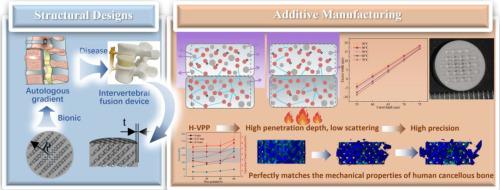Design and high-precision heated vat photopolymerization fabrication of bio-inspired gradient porous zirconia toughened alumina ceramics
IF 14.3
1区 材料科学
Q1 MATERIALS SCIENCE, MULTIDISCIPLINARY
引用次数: 0
Abstract
Zirconia-toughened alumina (ZTA) ceramics exhibit outstanding potential for load-bearing orthopedic implants like intervertebral fusion cages, owing to their excellent mechanical properties and biocompatibility. However, the high elastic modulus and inherent brittleness of ZTA ceramics pose manufacturing challenges that limit clinical applications. Biomimetic structural design combined with vat photopolymerization 3D printing offers a promising solution for developing personalized ZTA fusion cages. Nevertheless, ultraviolet (UV) light scattering from the ceramic. Particles reduce printing resolution, leading to significant variations in the designed mechanical performance. In this study, bio-inspired porous ZTA ceramic fusion cages were developed, featuring a solid outer shell (0.25–0.5 mm thickness) with 50% core average porosity and 20%–60% porosity gradient. Mechanical simulations reveal that their mechanical compatibility with human autogenous bone tissue originates from the porosity gradient architecture and enlarged load-bearing zone, which optimizes stress distribution to enhance bearing capacity. For high-precision additive manufacturing of ZTA ceramic green bodies, a heated vat photopolymerization (H-VPP) technique was developed. By elevating the forming temperature, the exposure energy density required to achieve the same cured depth is reduced, which minimizes horizontal UV light scattering. The sintered ZTA ceramic fusion cages successfully replicate human autogenous bone tissue characteristics, exhibiting compressive strength of 32–198 MPa and elastic modulus of 2.4–6.6 GPa.

仿生梯度多孔氧化锆增韧氧化铝陶瓷的设计与高精度热缸光聚合制备
氧化锆-增韧氧化铝(ZTA)陶瓷由于其优异的力学性能和生物相容性,在椎间融合器等承重骨科植入物中具有突出的潜力。然而,ZTA陶瓷的高弹性模量和固有的脆性带来了制造挑战,限制了临床应用。仿生结构设计与还原光聚合3D打印相结合,为开发个性化ZTA融合笼提供了一种很有前途的解决方案。然而,紫外线(UV)光从陶瓷散射。颗粒降低了打印分辨率,导致设计机械性能的显著变化。本研究开发了仿生多孔ZTA陶瓷融合笼,具有固体外壳(0.25-0.5 mm厚度),岩心平均孔隙率为50%,孔隙度梯度为20%-60%。力学模拟结果表明,其与人体自体骨组织的力学相容性来源于孔隙梯度结构和扩大的承载区,优化了应力分布,提高了承载能力。针对ZTA陶瓷绿体的高精度增材制造,开发了一种热釜光聚合(H-VPP)技术。通过提高成型温度,降低了达到相同固化深度所需的曝光能量密度,从而最大限度地减少了水平紫外光散射。烧结的ZTA陶瓷融合笼成功复制了人体自体骨组织的特征,抗压强度为32 ~ 198 MPa,弹性模量为2.4 ~ 6.6 GPa。
本文章由计算机程序翻译,如有差异,请以英文原文为准。
求助全文
约1分钟内获得全文
求助全文
来源期刊

Journal of Materials Science & Technology
工程技术-材料科学:综合
CiteScore
20.00
自引率
11.00%
发文量
995
审稿时长
13 days
期刊介绍:
Journal of Materials Science & Technology strives to promote global collaboration in the field of materials science and technology. It primarily publishes original research papers, invited review articles, letters, research notes, and summaries of scientific achievements. The journal covers a wide range of materials science and technology topics, including metallic materials, inorganic nonmetallic materials, and composite materials.
 求助内容:
求助内容: 应助结果提醒方式:
应助结果提醒方式:


